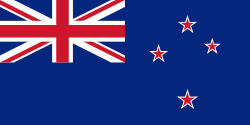Hot Water Beach (Hot Water Beach)
Hot Water Beach is a beach on the east coast of the Coromandel Peninsula, New Zealand, just south of Mercury Bay. It is approximately 12 kilometres south east of Whitianga, and approximately 175 kilometres from Auckland by car. Its name comes from underground hot springs that filter up through the sand between the high and low water tidal reaches. The beach is a popular destination both for locals and tourists visiting New Zealand. Annual visitor numbers have been estimated at 700,000, making it one of the most popular geothermal attractions in the Waikato region.
Within two hours either side of low tide, it is possible to dig into the sand allowing hot water to escape to the surface forming a hot water pool. The water, with a temperature as hot as 64 °C (147 °F), filters up from two underground fissures located close to each other. These natural springs can be found on the beach opposite the off-shore rocks. Visitors often dig large holes and relax and soak in the thermal water. Many visitors bring a spade and bucket with them. Spades can also be hired from the nearby surf shop.
Within two hours either side of low tide, it is possible to dig into the sand allowing hot water to escape to the surface forming a hot water pool. The water, with a temperature as hot as 64 °C (147 °F), filters up from two underground fissures located close to each other. These natural springs can be found on the beach opposite the off-shore rocks. Visitors often dig large holes and relax and soak in the thermal water. Many visitors bring a spade and bucket with them. Spades can also be hired from the nearby surf shop.
Map - Hot Water Beach (Hot Water Beach)
Map
Country - New_Zealand
 |
 |
| Flag of New Zealand | |
The islands of New Zealand were the last large habitable land to be settled by humans. Between about 1280 and 1350, Polynesians began to settle in the islands and then developed a distinctive Māori culture. In 1642, the Dutch explorer Abel Tasman became the first European to sight and record New Zealand. In 1840, representatives of the United Kingdom and Māori chiefs signed the Treaty of Waitangi, which in its English version declared British sovereignty over the islands. In 1841, New Zealand became a colony within the British Empire. Subsequently, a series of conflicts between the colonial government and Māori tribes resulted in the alienation and confiscation of large amounts of Māori land. New Zealand became a dominion in 1907; it gained full statutory independence in 1947, retaining the monarch as head of state. Today, the majority of New Zealand's population of 5.1 million is of European descent; the indigenous Māori are the largest minority, followed by Asians and Pacific Islanders. Reflecting this, New Zealand's culture is mainly derived from Māori and early British settlers, with recent broadening of culture arising from increased immigration. The official languages are English, Māori, and New Zealand Sign Language, with the local dialect of English being dominant.
Currency / Language
| ISO | Currency | Symbol | Significant figures |
|---|---|---|---|
| NZD | New Zealand dollar | $ | 2 |
| ISO | Language |
|---|---|
| EN | English language |















